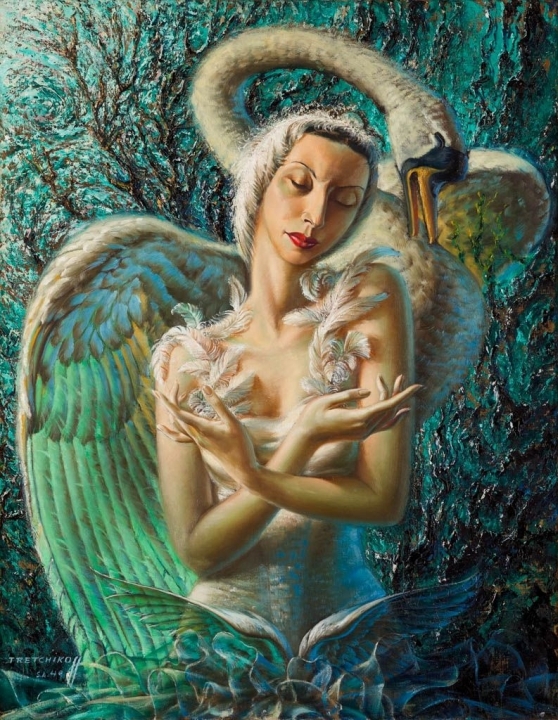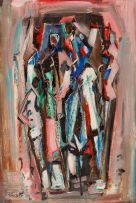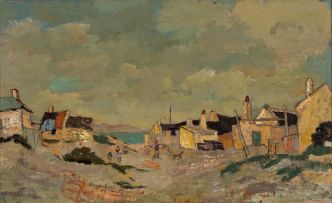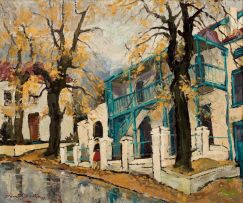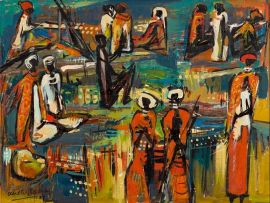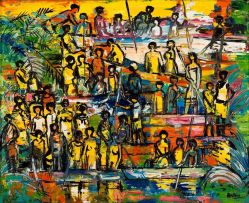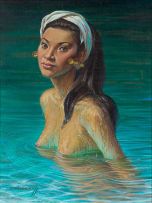Alicia Markova "The Dying Swan"
Vladimir Tretchikoff
Incl. Buyer's Premium & VAT
About this Item
signed, dated 49 and inscribed 'S.A.'
Notes
Accompanied by the books:
Buncher, Richard. Tretchikoff. De Luxe edition specially published for America, limited to 1500 copies of which this is number 115, signed and dated 1952 by the artist. Further inscribed with a dedication to the original owner from the artist, signed and dated 20 Oct 53, on the foreword page.
Timmins, Howard. Tretchikoff. De Luxe edition specially published for South Africa, limited to 400 copies of which this is number 24, signed by the artist. Further inscribed with a note to the original owner, on the frontis page, signed and dated 1973 and accompanied by a print of Lenka, signed and dated 70
Tretchikoff, Vladimir and Hocking, Anthony. Pigeon's Luck. Collins, London, 1973
Below is the artist's description, from his autobiography Pigeon's Luck, of how this painting came to be:
The Schlesinger organisation was sponsoring a tour of South Africa by the Royal Ballet from London, with its principals Alicia Markova and her partner, Anton Dolin. When I returned to Cape Town Natalie and I went to see them dance, and I was so intrigued that I went to see them rehearse. I was sitting in the stalls with a friend nicknamed Silver Fox from his pure white shock of hair. Markova was dancing the Dying Swan in 'Swan Lake' and I found the experience moved me deeply.
'I want to paint her,' I told Silver Fox. 'Why don't you ask her manager? He's sitting next to us.' When the rehearsal was over Silver Fox introduced me to Markova's manager, and told him of my idea. He did not look enthusiastic. 'Not a chance,' he said. 'There's no time.' 'If anyone can paint Alicia this is your man,' he said earnestly. 'He'll make it something special.' The manager hardly stirred. 'Got anything to show me?' he asked, obviously bored stiff by the whole idea. 'Not here,' I said. 'But my studio's just around the corner from your hotel. If you have a few minutes to spare I'll come and fetch you.' 'Okay. I'll give you five minutes tomorrow morning. Pick me up at nine sharp.'
At the studio the next morning he looked through my paintings, and it amused me to find that this hard-headed American so long immersed in the cut-and-thrust of show business was not indifferent to them. In fact, he stayed all morning.
'All right,' he said at last. 'You've convinced me. Now let's see what Alicia has to say.' She liked the paintings too. But when I told her I wanted to paint her as she appeared in 'Swan Lake', she sadly shook her head. 'No time at all,' she said. 'When could we do it? In the mornings I rehearse and in the evenings we perform.' 'I'd be prepared to fall in with your arrangements,' I said. 'Fit in an hour here, an hour there. I'll follow you round the country if need be.' She laughed.
'All right,' she said. 'You're on. I'll give you all my free time - but there's not all that much of it, I'd better warn you now.'
I began work as soon as possible. First I had to paint the background, and with it the outline of the Dying Swan itself to balance the ballerina. By the time it was ready the ballet had moved on to Johannesburg and I had to pack my bags and follow them. I checked in at the Carlton.
There was a problem in that in Johannesburg I had no studio. But that was soon overcome. When the hotel manager heard of the difficulty he gave me the best suite in the hotel at no extra charge, the lightest and airiest in the building and an ideal working space.
My idea in the Dying Swan was to paint Alicia intertwined with the bird she portrayed, the two inseparable in the moment of death, the end of the dance. Alicia was infinitely patient in the long hours of posing and as generous with her free time as she had promised. Strange as it may seem, Alicia's co-operation had a great influence on the painting. With the ballerina so unselfish I was doing my damnedest to produce my best.
When it was time for the company to move on to Pretoria, I went with them. One evening in Pretoria I went down to see Alicia dance yet again, watching from the wings with no less enthusiasm than I had the first time, when I felt a tap on my shoulder. It was Anton Dolin, Alicia's partner.
'Hello there,' he whispered. 'Back to see the dance of the Dying Duck?' He startled me. 'What do you mean?' 'Don't you know? In the business that's the nickname we have for the Dying Swan.' 'I've got news for you,' I said. 'You know the swan in the painting? I couldn't get the real thing, so I painted it from a dead duck.'1
Dame Alicia Markova, DBE, (1910 - 2004) was an English ballerina, choreographer, director and teacher of classical ballet. She is widely considered to be one of the greatest classical ballet dancers of the 20th century. The first British dancer to become the principal dancer of a ballet company and, with Dame Margot Fonteyn, is one of only two English dancers to be recognised as a prima ballerina assoluta, a title given only to the most notable of female ballet dancers. She was a founder dancer of the Rambert Dance Company, The Royal Ballet and American Ballet Theatre, and was co-founder and director of the English National Ballet.
1 Tretchikoff, Vladimir and Hocking, Anthony. Pigeon's Luck. William Collins Sons & Co Ltd, London, Glasgow, Sydney, Auckland, Toronto and Johannesburg. 1973. pages 188-190.
Provenance
Lady Lynn Bagnall
Dance Transition Resources Centre (DTRC), Toronto 1999 (donated by Mr Todd Edgar, nephew of Lady Bagnall)
34Long Art Gallery, Cape Town, 2005
Acquired from the above by the present owner, 2008
Exhibited
The Iziko South African National Gallery, Cape Town, Tretchikoff Retrospective Exhibition, 26 May to 25 September 2011
Literature
Buncher, Richard. Tretchikoff. Howard Timmins, Cape Town, 1951, illustrated in colour plate 26
Timmins, Howard. Tretchikoff. Howard Timmins, Cape Town, 1969, illustrated in colour
Lamprecht, Andrew (ed.). Tretchikoff: The People's Painter. Jonathan Ball Publishers, Johannesburg and Cape Town, 2011, illustrated in colour on pages 132-133
